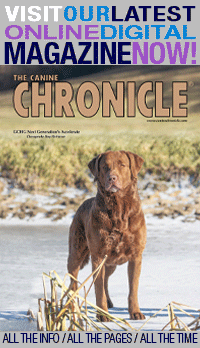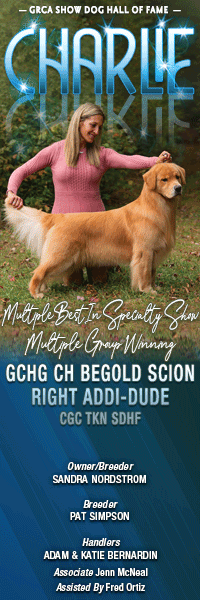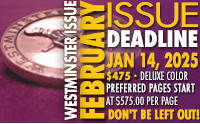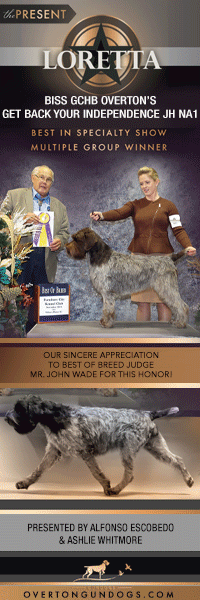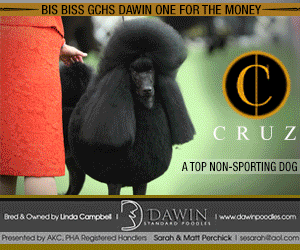Exactness of Meaning
From October, 2010
By Dr. Gareth Morgan-Jones
Quite often when one participates in, or overhears, a conversation concerning the pedigreed dog the word ‘correct’ is seemingly used with great abandon. It has now apparently become one of those elements in our language which we employ with considerable frequency but yet do we oftentimes really consider what we mean when we use it and, as a result, is it always applied in proper context? Are we always aware of how it should be defined? Do we ever qualify it with a follow-up; correct in what sense, for what purpose? Has it now, perhaps, become so loosely and cursorily thrown in so as to lose its potency and intended meaning? Are we compromising a certain connotation here when we use it too casually? Is the point or special significance one intends to convey sometimes lost? Is there a lack of precision and exactness sometimes at play here? When one says that something is correct it essentially means that it conforms to a certain set, approved standard; conforming to or agreeing with a particular yardstick, a means of defining what something should be. The problem, however, arises when we fail to differentiate between merely an interpretive opinion about something, as opposed to reality or truth. I have visited this subject several times previously but having another stab at it, from a slightly different angle, seems too tempting to resist. Having just returned from participating in yet another National Specialty judges’ education program this matter still bothers me some. Hence this further consideration. How many times during the course of this recent experience did I hear a remark such as ‘oh, but that’s not correct’? I kind of lost count, it occurred so frequently.

Let me put this in some context by giving an example of how this word is sometimes used in another area of human interest. I do not know how many of my readers will be even remotely familiar with bonsai, that highly eclectic and esoteric human activity involving the cultivation, miniaturization, and styling of trees in relatively small ceramic containers. It is an indulgence (I dabble some myself) in which horticultural prowess and the practice of aesthetic taste go hand in hand, in close association. There is technical know-how and artistry intermixed. Not too long ago I read a critical commentary on a particular tree by someone who obviously fancies himself as an authority and is what you might well call self-opinionated. Following an inspection of the position of the branches it was declared that the apex was ‘not correct’, being supposedly too far to the left. He went on to state, and I quote, ‘the apex needs to be placed more to the right in order for it to occupy the best position’. Yes, really! Now it so happens that there are some long-standing rules which one should follow in the process of designing but there is now a sort of battle going on between traditionalists and those who favor a more so-called naturalistic style. And so it goes, there can be a never-ending and polarizing argument generated as to what is or is not ‘correct’. Likewise in the world of the purebred dog. There is always this extant danger of lessening the value of a word to such an exent that it becomes meaningless within a certain context. Quite obviously, as I have suggested previously, when maintaining that one feature or other is or is not correct within a given breed there has to be an awareness of reality and, in particular, an appreciation of the phenomenon of naturally-occurring variation. This is not an area where some whim or capricious idea holds currency. In other words, we have to be very careful in how we use this word ‘correct’. If there is a certain lack of exactness and preciseness, or if the word is just plainly used too casually, quite clearly its usefulness is diminished.
Within the confines and firmament of pedigreed-dog conformation competition there are certain variables which oftentimes have to be taken into account and the personal-opinion factor, on occasion, inevitably slips in under the radar. There is also the problem of a shifting dynamic. What may be deemed ‘correct’ at any given time may not always have the status of permanence. When discernible breed changes become evident in the process of development and refinement quite obviously some appropriate accommodation has to be made. But this is by no means easily achieved and there will always be room for disagreement. There are few persistent absolutes in this regard, by the very nature of selective breeding practices, and so, within certain parameters, there has to be some flexibility. Quite obviously we cannot be too narrowly opinionated in this area. When retrogressive breed drag becomes evident there has to be some understanding of causes and effects. Everything has to be placed in prespective. Many breeds have mixed ancestries and particular traits will inevitably recurr. If some hound characteristics, in a somewhat diluted form, still continue to crop up in certain sporting breeds this surely has to be placed in historical context. Deviation from a present-day ideal has to be dealt with in a meaningful way. It is often quite remarkable (perhaps astonishing) how much genetic resilience there is within particular entities. Witness the residual remnants of the Foxhound and Greyhound which are sometimes evident in the Pointer, in respect of ears/width of top skull and topline, respectively, even to this day. Extents of correctness among exhibits should be a direct reflection of the degree to which they conform to the requirements documented in their respective standards. But things, unfortunately, are never quite that simple.

In order to adopt an appropriate perspective on the matter of what is or is not ‘correct’ in a given breed at a particular time one must exercise a certain understanding of the morphological and structural variables existing within it. Knowledge of ancestral history surely helps. As I have suggested above, a certain breadth of comprehension and thinking is required. Within what is conceptualized as the ideal there will always be some degree of variation and this will not always occur exactly to the same extent. Take the Pointer head, for instance. Parallel planes of the skull and muzzle are equally acceptable to a ‘dish’ condition, where the nasal bone is so formed that the nose is slightly higher at the tip than the muzzle at the stop. We are considering form and function here but there is no preference. Both configurations are ‘correct’. Given the diversity which exists within breeds one has to be very careful when it comes to determining the extent of correctness. We are oftentimes essentially dealing with degrees of approximation here. The distance between what is idealized as perfection and actuality will differ, sometimes quite considerably. We always have to face the fact that reality never quite measures up to man’s concept of the ideal. It gets close sometimes, othertimes there is some way to go. There is always a certain genetic dynamic at play, which we have to be aware of. Breed populations invariably drift over time, some are deliberately altered by selective breeding in the name of development and betterment, others suffer from inherent, retrogressive drag unless breeders are consistently on top of their game, so to speak.
When we fail to remember some of the fundamentals of biological reality our prespective on such a matter as what is or is not ‘correct’ within a given breed can get somewhat askew and out of line. There is seemingly always this tendency to focus much too narrowly and go way beyond the dictates contained in standards. Although the fundamental end toward which effort is directed and expended by breeders involves the preservation of essential breed characteristics it has to be borne in mind that total morphological uniformity is not exactly attainable. Some divergence of form within the entitites which we refer to as breeds will always exist and it is within this reality that we have to define with some exactness what we mean by being or not being ‘correct’. Some measure of homogeneity is, of course, highly desirable but there has to be certain accommodation made for diversity. This is surely not an area for the practice of personal, myopic preference. A narrow view in this context is not necessarily always an enlightened one. When one hears someone declare, sort of off-the-cuff, ‘oh, that’s not correct’ there is oftentimes a need to evaluate the remark with reference to the content of a breed standard. All too often, unfortunately, this type comment is merely a superficial reaction to some dislike or other. It’s a little bit like the fault judge who declares ‘oh, I can’t stand so-and-so’.

Let me illustrate the instability in our sometimes off-based notions of what is deemed to be ‘correct’ in a particular breed by considering an aspect of the Pembroke Welsh Corgi’s conformation. It is now widely thought of as being a long and low dog but, although short on leg, the proportions of the working dog on the Welsh farms were appreciably different from those of the present day show dog. It was essentially a highly alert, agile, shortish-backed little dog that drove the cattle to market by nipping on their heels, brought in the cows from the pasture to be milked and rounded up the chickens and geese so that they could be secure in their pens at night before the real fox showed up. I remember it well, I grew up with this breed. If we are talking form and function this was a dog well able to perform certain tasks. Now the question arises: would these long dogs that move like caterpillars which we sometimes see nowadays be able to adequately meet the traditional demands? Probably not, but then people still think that they are ‘correct’. It’s a matter of context, isn’t it? There was a time when the standard of this breed in its country of origin (as in the January 1950 version) called for substance and stamina in a small space, with a body ‘of medium length’. Then someone suggested that ‘the length of the body, measured from the centre of the shoulder blade to the set-on of tail, should exceed the height at shoulder by as nearly as possible one-fifth’ (that’s twenty-percent). This was, of course, a purely arbritrary supposition, a sort of hypothesis, but it went on from there and we’ve ended up with ‘moderately long’, with distance from withers to base of tail forty-percent greater than distance from withers to ground. Then the false notion that this breed can never be too long does the rounds. How did all this happen and where will we end up? Has this come about by mere individual or collective preference on the part of latter-day fanciers, so that arbitrariness suddenly translates into correctness? So where does what we mean by ‘correct’ fit in all of this? It all depends, does it not? It all becomes a mental mish-mash of contradictory opinions and viewpoints.
As I have pointed out previously, on more than one occasion, there exists a certain genetic legacy derived from breed histories and ancestries. This is also, of course, the result of selective breeding practices over time. Hence there are inevitable differences among populations of the same breed even within a single country, let alone where geographical isolation has existed over an extended period of time. Then a question often arises; which form is ‘correct’? There are so many examples. Who is to make such a determination? Does this type query even have any real meaning and how does one go about obtaining an authoritative answer? Are there ever areas of doubt surrounding this very subject? So how does one go about accommodating this phenomenon? And what about the sometimes substantial dichotomy between dogs bred specifically for conformation competition and those still bred to fulfill the function for which the breeds were originally developed? Then it presumably becomes ‘correct for what purpose’? So how should one adapt one’s thinking and reach the right mental disposition to exercise restraint and possess imperturbability when confronted with this ‘correctness’ matter? Are you able to view this in proper context or are you perfectly content to use this word ‘correct’ in whatever way you wish, however loosely?

Short URL: https://caninechronicle.com/?p=1513
Comments are closed
